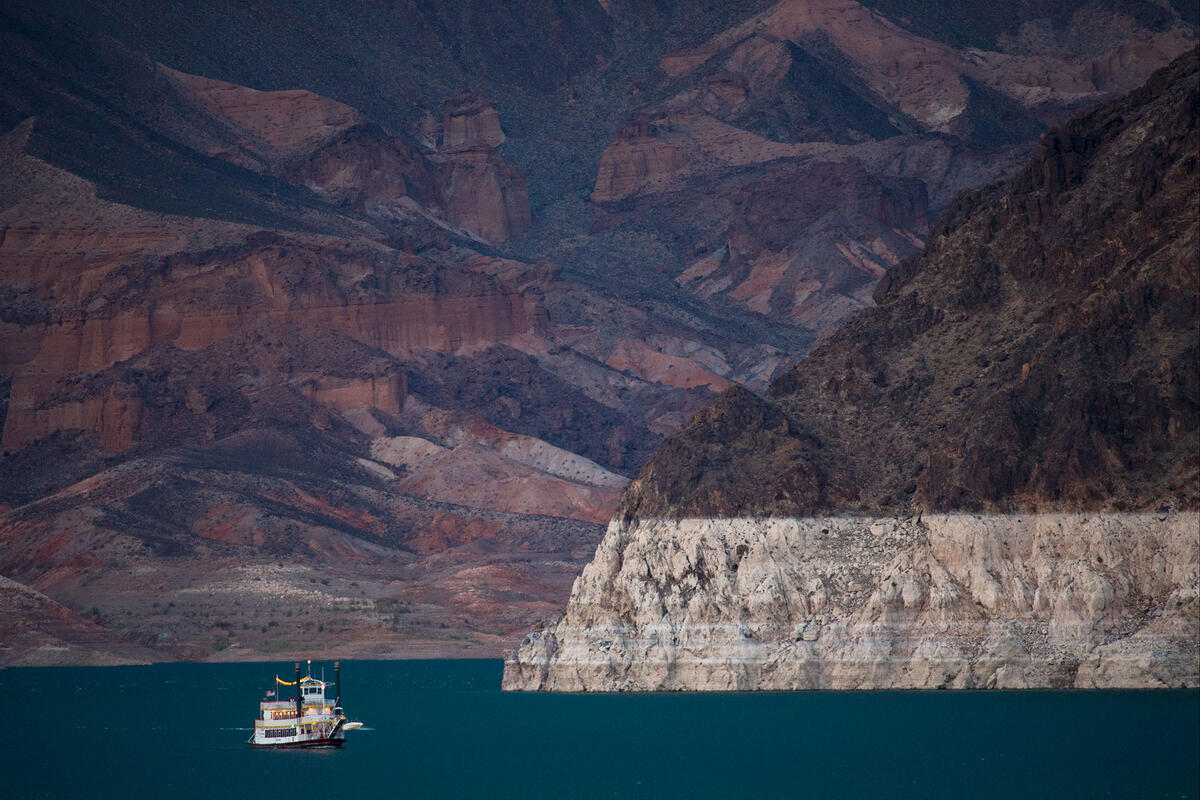Few issues in the world are bigger than the crisis of water resources. Drought and flooding have plagued humanity since the dawn of history, but climate change is driving extremes that are affecting billions all over the world. And the crisis is not confined to far-off places. Drought and flooding are ripping through the American West — including Nevada and California — threatening the social, legal, and political status quo.
At UNLV’s William S. Boyd School of Law, two scholars, women with very different resumes but a world of experience, are perhaps uniquely positioned to confront the issues of water.
Jean Sternlight is the Michael and Sonja Saltman Professor of Law, where she has been, since 2003, the first and only director of the Saltman Center for Conflict Resolution. She received her law degree from Harvard University, where she served as editor-in-chief of the Harvard Civil Rights-Civil Liberties Law Review. She also clerked for federal judge Marilyn Hall Patel in California and subsequently practiced plaintiff-side employment law in Philadelphia.
A bit self-effacing when it comes to water issues, she noted that science and technology are important components. But she also is acutely aware of the importance of mediation and dialog to resolving natural resource conflicts, and — for the Saltman Center — conflict resolution is the mission.
Hot Topic
“This is a very hot topic that many different groups are focusing on,” Sternlight said.
One of those who consider water a “hot topic” is Patricia Mulroy, a more recent addition to the Saltman Center roster. A leader in the international water community for more than 25 years, Mulroy is the former top administrator of the Southern Nevada Water Authority, the region’s water wholesaler, and the Las Vegas Valley Water District, which brings water to taps throughout the city of Las Vegas and unincorporated Clark County, including the Strip. At Boyd, Mulroy serves as a senior fellow for climate adaptation and environmental policy and as a practitioner-in-residence for the Saltman Center. Additionally, she holds a faculty position at the Desert Research Institute.
The Colorado River resource, how to use it, share it, and protect it, Sternlight and Mulroy agree, is a critically important environmental and natural resource issue for the West, the United States, Mexico, and, by extension, a stressed-out planet.
The center uses the tools of communication, mediation, and public participation to negotiate solutions to all sorts of problems, especially those thorny public policy issues that too often seem overwhelming or intractable.
Water has always been a resource that provokes fights, particularly in the American West. Ranchers and farmers versus miners, cities versus rural inhabitants, newcomers versus indigenous people: Now Earth itself, which once welcomed millions to the West Coast with regular rainfall and an astonishingly comfortable climate, has seemingly turned against us.
Global Issue
Of course, the conflict over water is nothing new. Its scope is now global.
“Global concern about water has grown steadily in the last years, with the World Economic Forum now listing it as one of the planet’s top challenges,” Mulroy said. “As fears and concerns grow, it becomes more important than ever to set the right tone so that we can find those strategies of coexistence that balance all the diverse needs, including preserving the ecosystem around us. It reinforces the need to educate the new generation of lawyers to be one that finds opportunities and common ground and not one that hardens positions and seeks to create winners and losers.”
We must choose between sinking in conflict or swimming with negotiation, Sternlight suggested.
“One way or another, these issues ultimately will be resolved,” she said, ideally without violence or punishing judicial decrees.
The “Turbulent Waters: Brokering a Secure World” conference in January was not the first time the law school and the Saltman Center hosted an event focusing on water issues in the West. In September 2013, it hosted “Water Law in the West: A Panel Discussion with Patricia Mulroy;” and in October 2007, “Collaboration and the Colorado River.”
No Easy Solutions
But Sternlight warned that even with the ministrations of the center, not every problem has a
solution. Simply put, “Collaboration doesn’t work when the issues are such that people cannot reach an agreement,” she said. Impediments to solutions can include personalities that refuse to accommodate other perspectives and needs. Perhaps counter intuitively, she said severe imbalances of power could make resolving differences harder to achieve. And there are power imbalances on the Colorado River, she noted.
California gets 4.4 million acre-feet of water from the river system annually, delivered through the massive reservoir outside of Las Vegas called Lake Mead. Nevada, however, is allocated less than one-seventh that amount. And Arizona, by federal law, is the first state that will face cuts in the increasingly likely event that water shortages are formally declared.
Mulroy, in her time with the Saltman Center, has had the opportunity to speak to several classes of future lawyers. Her message, she said, is consistent.
“In the area of water resources, look to the law for the opportunities it can create and not as the sword by which to stop something,” she said. “Legal confrontations by definition have winners and losers, something which in this space has never played out well over time. The greatest example of that is the infamous case of Arizona v. California. In this 20-year-plus lawsuit, the state of Arizona won the right to use its tributary, the Gila River, and not have it count towards its Colorado River allocation. The decision came over the objections of California, which saw the tributary as part of the larger system.
“Having lost that lawsuit, California took advantage of the opportunity to right the wrong they felt they had suffered in court when Arizona went to Congress to get funding for the Central Arizona Project. The much larger delegation from California prevailed in attaching an amendment to that legislation that subordinated the entire supply being delivered by the project to all of California’s uses, Mulroy said. “In other words, in the event of a shortage, the state of California would not have to reduce its use by a gallon until there was no water going through the Arizona canal. Arizona essentially won the battle and lost the war. Litigation didn’t help solve the problem. It, in fact, made it worse.”
The conclusion from this protracted war of law and politics? “The future of water law lies in mediation, not in litigation,” she said.
Science vs. Politics
Bringing reasonable people together to discuss science and public policy is great, and certainly provides a forum for various stakeholders — and we are all stakeholders — to find solutions that serve the common interest. But is it always possible to find those solutions? Not only are some of those with the most to gain (or lose) sometimes firmly resistant to solutions, but there are plenty of people, some of them in policymaking or policy-implementing positions, who don’t believe the problems exist at all.
The data collected by scientists throughout the West cannot always be easily reconciled with the political answers.
“Science and the discipline of scientific discovery are never static and never absolute,” Mulroy said. “Scientists report observed changes and events and seek causal relationships. They are quick to adapt as new data emerges that may lead to changed conclusions.
“No one denies that there has been a noticed change in weather patterns, with greater extremes occurring each year. The argument is around what is causing it — is it a natural cyclical event or the consequence of burning fossil fuels?”
The cause, however, ultimately is not the prime concern of water managers, Mulroy said.
The Need to Adapt
“Whatever the reason for our new weather reality, we have to adapt to those changed conditions,” she said. “In that regard it is much easier to deal with the consequences of climate change and find adaptation strategies. The challenge is how to do it in a way that won’t cause massive economic fallout and in some instances destroy the economic underpinnings of entire nations.
“Today’s scientific discovery will invariably be challenged tomorrow by new data,” she said. Climate science over the last years has evolved. Early assumptions have been refined. For water planners, that means a disciplined and continual partnership with the science community is essential.”
Remaining Upbeat
Certainly, there are challenges. Mulroy, though, remains resolutely upbeat, even sanguine, about the possibilities for communication and collaboration. The most obvious example is the comparison between what has happened on the Colorado River and the unresolved events, including litigation, around the California Bay Delta amid crushing drought.
“Although the Colorado River has suffered through 15 long years of debilitating drought, the agreements that have been forged over the years have averted catastrophic consequences,” Mulroy said. “Incrementally, this region has adapted to conditions as they unfolded.”
But next door, things are not so good.
“Conversely, the story of California’s drought has been the story of missed opportunities,” she said. “The regions have been bitterly divided, refusing to forge a common strategy and choosing instead to face off in court. So when the worst of the drought hit, there were no tools to soften the blow and mitigate the damage. The years leading up to the system crash in which there was additional water that could have been stored were lost; all that was left were draconian drought measures and much suffering by all sectors.”
Sternlight said that although another water-focused conference hasn’t been scheduled, the issues are too big to go away and the need for conflict resolution will remain. Despite the challenges, she said she too is generally an optimist when it comes to finding solutions to contentious policy debates, but she tempers that optimism with a bit of realism.
“Hope for the best,” she said. “Prepare for the worst.”


